A roundup of books on activism, social justice, and histories of protest
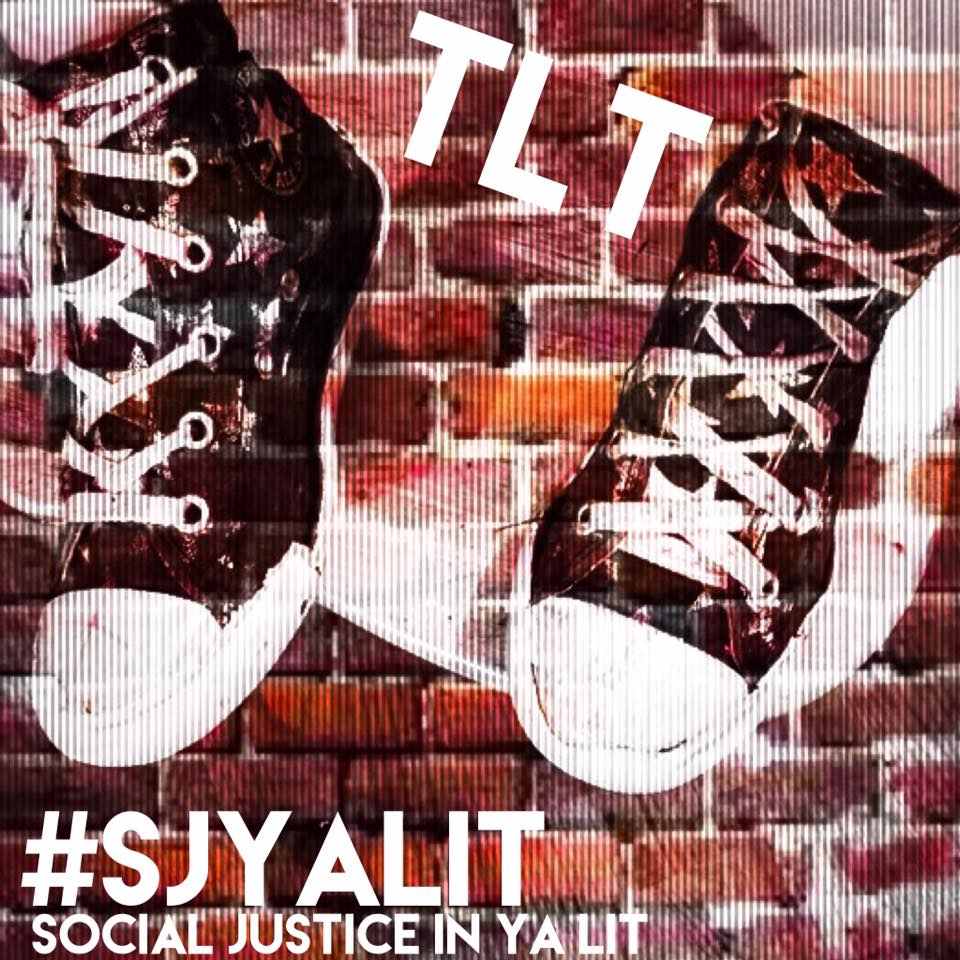
Hello from Minnesota. My friends, I don’t know what to say. But I DO know some things to do. We have been donating to many local and national groups (Hennepin County Library, Pimento Relief Fund, Unicorn Riot, Communities United Against Police Brutality, Reclaim the Block, Migizi, and Black Visions Collective). I have been gathering resources for friends and colleagues. I have been continuing to educate myself and do the work of continuing to listen, learn, unlearn, and grow. I have been continuing to have conversations with my white teen son about racism, activism, and being anti-racist. As it’s so often said: it’s a privilege to have to learn about racism and not to have to experience it.
White friends, particularly those of us raising white boys: Talk about racism. Talk about systemic oppression. Talk about police violence. Talk about institutionalized racism. Talk about white privilege. Talk about toxic masculinity. Talk about white supremacy. Talk about intervening. Talk about speaking up. Hold people accountable, including yourself. Call them out. Call them in. Educate yourself. Interrogate your own prejudices. Actively work to be anti-racist. Stand in solidarity. Be outraged. Don’t be silent. Don’t be complicit. Reflect. Create change. Really dig into what is happening—not just the moments, but the movements. Interrogate the idea that “the system is broken” and look at what it means to instead acknowledge that the system is functioning exactly as it was built to function, and what does that mean and how do we change that. Care about people and movements and justice not just in moments of tragedy but all the time. Don’t wonder when we will go back to “normal” and don’t be complicit in allowing what many of us have come to accept as normal to remain how things are. Figure out how to dismantle racism and help dismantle other systems that depend on oppression and white supremacy. As Jason Reynolds said just the other day during the #KidLit4BlackLives rally, “Crawl toward judgement; sprint toward understanding.”
ADVERTISEMENT
ADVERTISEMENT
Black lives matter. George Floyd matters. Structural and institutional and cultural change matters.
Below are a handful of books I’ve reviewed in the recent past that address activism, protest, and social justice. It’s important that young readers see the strong and powerful history our country has of assembly, free speech, and activism. The books represent many issues—LGBTQAIP+ history, environmental justice, gun control, voting rights—and show how young people have always been not just involved in but at the forefront of social movements and cultural and political change.
I also link to my presentation on Social Justice and Activism in YA Lit from last year at Teen Lit Con. Please be sure to scroll to the very end for two wonderful books that feature Minnesota teens. Search this blog for many other resources on these topics including reading lists and book reviews. You can find an extensive list of posts at TLT that address social justice from our 2017 year-long project on Social Justice in YA Literature (#SJYALIT). If you missed last week’s posts at TLT, check out Because Black Lives Matter, a Collection of Resources, Because Black Lives Matter, Read Black Authors, and Because Black Lives Matter, a Collection of Anti-Racist Reading Lists, as well as yesterday’s post Because Black Lives Matter: A Collection of Intersectional Resources.
There are so many wonderful resources out there for people of all ages, but especially for children and teens. Do the work. Research, read up, ask your white friends what resources they are finding and using to hold these conversations. Don’t ask your BIPOC friends to educate you. It’s 2020. Get googling. Check Twitter. Hit up your local library and put things on hold. Learn, unlearn, listen, grow.
As those of us in Minnesota are still fond of saying, in the words of Paul Wellstone, “We all do better when we all do better.”
(Descriptions of books with post-it note reviews are from the publisher.)
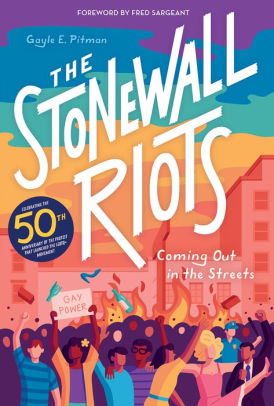
Gr 6–9—A thorough if somewhat disjointed examination of the events before, during, and in the aftermath of the Stonewall Riots gives young readers an overview of the LGBTQ+ activism of the 1950s and 1960s. Pitman traces meeting places, social clubs, and the rise of organizations and activist groups as well as the many police raids of gay establishments, focusing on the June 28, 1969, raid on the mob-owned Stonewall Inn. Due to a lack of documented accounts, use of pseudonyms, and conflicting reports, controversies remain over the actuality of events at Stonewall. Post-Stonewall, readers learn about the increase in radical groups and visibility that challenged negative attitudes and discrimination. Pitman occasionally expands the narrative focus to examine what was happening in various places around the country and to consider other issues and movements of the time, including weaknesses and missteps in the movement for LGBTQ+ rights. The unique approach of using various objects (matchbooks, leaflets, buttons, arrest records, photographs, and more, with many reproductions too small or low resolution to read) to guide, inform, and reconstruct the story of the riots prevents a smooth narrative flow and makes the text feel repetitive as it moves back and forth in time. Back matter includes a time line, notes, bibliography, and an index.
VERDICT An important look at a major moment in American history. Readers will come to understand why the iconic Stonewall Inn is now on the National Register of Historic Places, a National Historic Landmark, and a National Monument.
ISBN-13: 9781419737206
Publisher: ABRAMS
Publication date: 05/14/2019
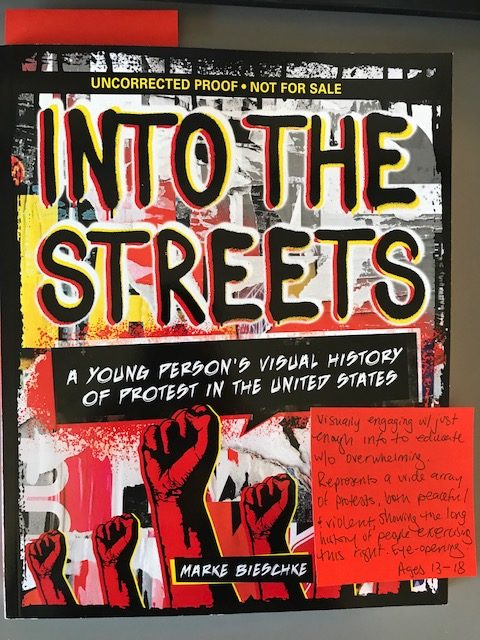
Into the Streets: A Young Person’s Visual History of Protest in the United States by Marke Bieschke (August 4, 2020)
This lively book guides readers through the art and history of significant protests, sit-ins, and collective acts of resistance throughout US history. Photos, artwork, signs, and other visual elements highlight the history of social action, from American Indian resistance to colonists through Black Lives Matter and Women’s Marches.
Into the Streets introduces the personalities and issues that drove these protests, as well as their varied aims and accomplishments, from spontaneous hashtag uprisings to highly planned strategies of civil disobedience. Perfect for young adult audiences, this book highlights how teens are frequently the ones protesting and creating the art of the resistance.
(POST-IT SAYS: Visually engaging with just enough info to educate without overwhelming. Represents a wide array of protests, both peaceful and violent, showing the long history of people exercising this right. Eye-opening. Ages 13-18)
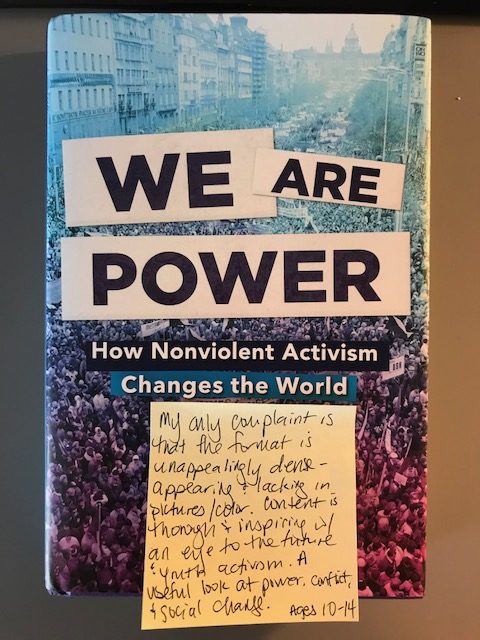
We Are Power: How Nonviolent Activism Changes the World by Todd Hasak-Lowy
A stirring look at nonviolent activism, from American suffragists to Civil Rights to the Climate Change Movement
We Are Power brings to light the incredible individuals who have used nonviolent activism to change the world. The book explores questions such as what is nonviolent resistance and how does it work? In an age when armies are stronger than ever before, when guns seem to be everywhere, how can people confront their adversaries without resorting to violence themselves? Through key international movements as well as people such as Gandhi, Alice Paul, Martin Luther King, Cesar Chavez, and Václav Havel, this book discusses the components of nonviolent resistance. It answers the question “Why nonviolence?” by showing how nonviolent movements have succeeded again and again in a variety of ways, in all sorts of places, and always in the face of overwhelming odds. The book includes endnotes, a bibliography, and an index.
(POST-IT SAYS: My only complaint is that the format is unappealingly dense-appearing and lacking in pictures/color. Content is thorough and inspiring with an eye to the future and youth activism. A useful look at power, conflict, and social changes. Ages 10-14)
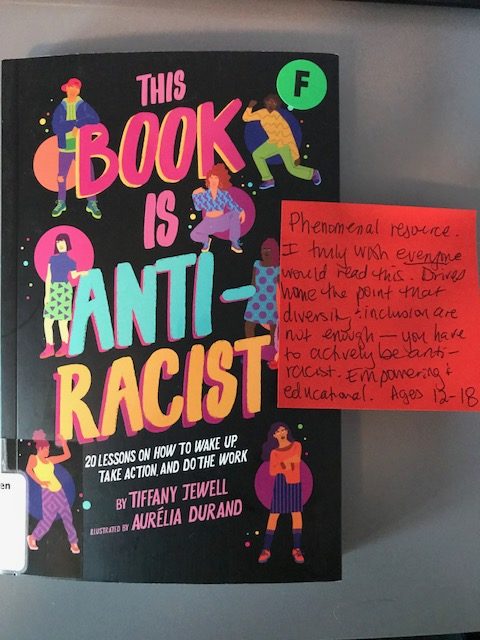
This Book Is Anti-Racist: 20 Lessons on How to Wake Up, Take Action, and Do the Work by Tiffany Jewell, Aurelia Durand (Illustrator)
Who are you? What is racism? Where does it come from? Why does it exist? What can you do to disrupt it? Learn about social identities, the history of racism and resistance against it, and how you can use your anti-racist lens and voice to move the world toward equity and liberation.
“In a racist society, it’s not enough to be non-racist—we must be ANTI-RACIST.” —Angela Davis
Gain a deeper understanding of your anti-racist self as you progress through 20 chapters that spark introspection, reveal the origins of racism that we are still experiencing, and give you the courage and power to undo it. Each chapter builds on the previous one as you learn more about yourself and racial oppression. Exercise prompts get you thinking and help you grow with the knowledge.
Author Tiffany Jewell, an anti-bias, anti-racist educator and activist, builds solidarity beginning with the language she chooses—using gender neutral words to honor everyone who reads the book. Illustrator Aurélia Durand brings the stories and characters to life with kaleidoscopic vibrancy.
After examining the concepts of social identity, race, ethnicity, and racism, learn about some of the ways people of different races have been oppressed, from indigenous Americans and Australians being sent to boarding school to be “civilized” to a generation of Caribbean immigrants once welcomed to the UK being threatened with deportation by strict immigration laws.
Find hope in stories of strength, love, joy, and revolution that are part of our history, too, with such figures as the former slave Toussaint Louverture, who led a rebellion against white planters that eventually led to Haiti’s independence, and Yuri Kochiyama, who, after spending time in an internment camp for Japanese Americans during WWII, dedicated her life to supporting political prisoners and advocating reparations for those wrongfully interned.
This book is written for EVERYONE who lives in this racialized society—including the young person who doesn’t know how to speak up to the racist adults in their life, the kid who has lost themself at times trying to fit into the dominant culture, the children who have been harmed (physically and emotionally) because no one stood up for them or they couldn’t stand up for themselves, and also for their families, teachers, and administrators.
With this book, be empowered to actively defy racism to create a community (large and small) that truly honors everyone.
(POST-IT SAYS: Phenomenal resource. I truly wish everyone would read this. Drives home the point that diversity and inclusion are not enough—you have to be actively anti-racist. Empowering and educational. Ages 12-18)
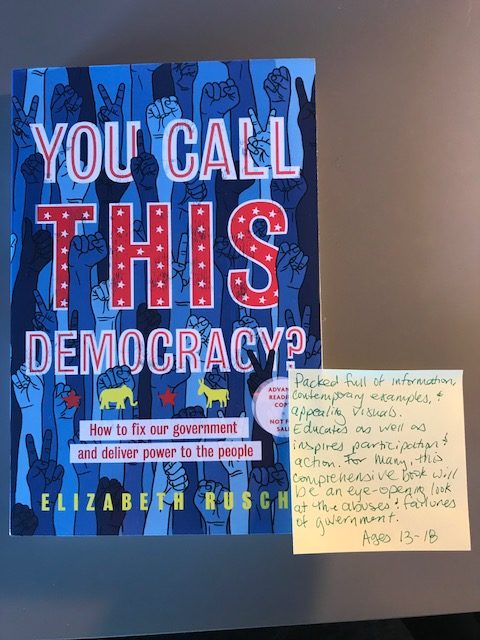
You Call This Democracy?: How to Fix Our Government and Deliver Power to the People by Elizabeth Rusch (3/31/2020)
All of the challenges facing our democracy today… problems with the electoral college, gerrymandering, voter suppression, lack of representation, voter disinterest, citizens who cannot vote, lobbying, money…lead to two questions: why doesn’t every vote really count? And what are we going to do about it?
Author Elizabeth Rusch examines some of the more problematic aspects of our government but, more importantly, offers ways for young people to fix them.
(POST-IT SAYS: Packed full of information, contemporary examples, and appealing visuals. Educates as well as inspires participation and action. For many, this comprehensive book will be an eye-opening look at the abuses and failures of government. Ages 13-18)
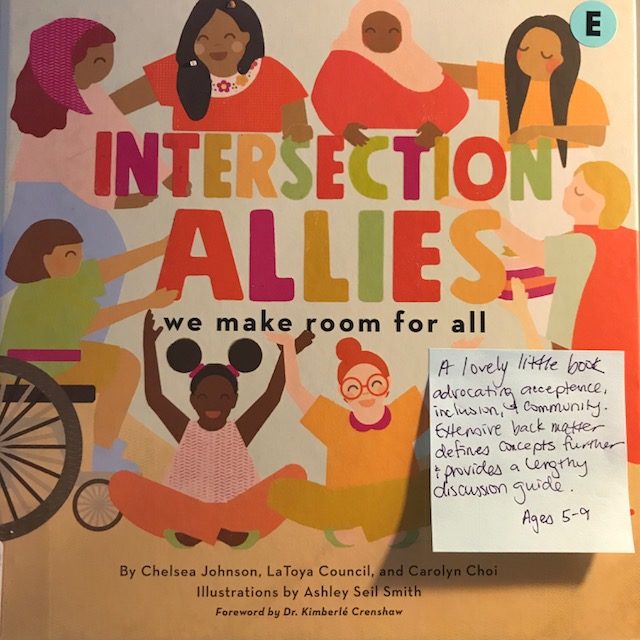
IntersectionAllies: We Make Room for All by Chelsea Johnson, LaToya Council, Carolyn Choi, Ashley Seil Smith
The brainchild of three women-of-color sociologists, IntersectionAllies is a smooth, gleeful entry into intersectional feminism. The nine interconnected characters proudly describe themselves and their backgrounds, involving topics that range from a physical disability to language brokering, offering an opportunity to take pride in a personal story and connect to collective struggle for justice.
The group bond grounds the message of allyship and equality. When things get hard, the kids support each other for who they are: Parker defends Kate, a genderfluid character who eschews skirts for a superhero cape; Heejung welcomes Yuri, a refugee escaping war, into their community; and Alejandra’s family cares for Parker after school while her mother works. Advocating respect and inclusion, IntersectionAllies is a necessary tool for learning to embrace, rather than shy away from, difference.
Featuring gorgeous illustrations on every page by Ashley Seil Smith, as well as powerful introductions by activist and law professor Dr. Kimberlé Crenshaw, who coined the term “intersectionality,” and Dr. Ange-Marie Hancock Alfaro, author of Intersectionality: An Intellectual History.
(POST-IT SAYS: A lovely little book advocating acceptance, inclusion, and community. Extensive back matter defines concepts further and provides a lengthy discussion guide. Ages 5-9)
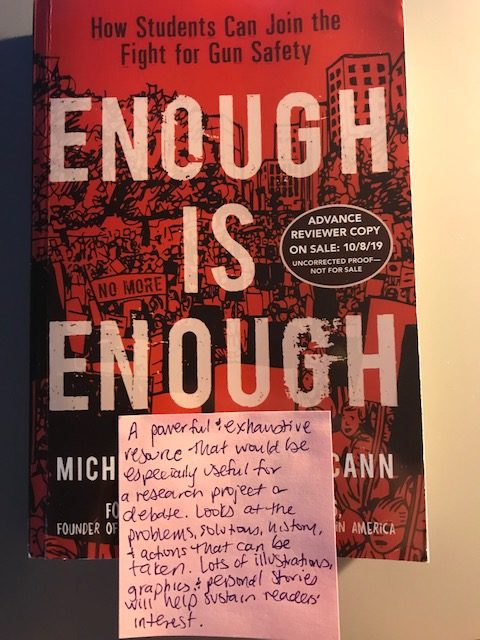
Enough Is Enough: How Students Can Join the Fight for Gun Safety by Michelle Roehm McCann, Shannon Watts (Foreword by) (ISBN-13: 9781582707013 Publisher: Simon Pulse/Beyond Words Publication date: 10/08/2019)
From award-winning author Michelle Roehm McCann comes a young activist’s handbook to joining the fight against gun violence—both in your community and on a national level—to make schools safer for everyone.
Young people are suffering the most from the epidemic of gun violence—as early as kindergarten students are crouching behind locked doors during active shooter drills. Teens are galvanizing to speak up and fight for their right to be safe. They don’t just want to get involved, they want to change the world. Enough Is Enough is a call to action for teens ready to lend their voices to the gun violence prevention movement. This handbook deftly explains America’s gun violence issues—myths and facts, causes and perpetrators, solutions and change-makers—and provides a road map for effective activism.
Told in three parts, Enough Is Enough also explores how America got to this point and the obstacles we must overcome, including historical information about the Second Amendment, the history of guns in America, and an overview of the NRA. Informative chapters include interviews with teens who have survived gun violence and student activists who are launching their own movements across the country. Additionally, the book includes a Q&A with gun owners who support increased gun safety laws.
(POST-IT SAYS: A powerful and exhaustive resource that would be especially useful for a research project or debate. Looks at the problems, solutions, history, and actions that can be taken. Lots of illustrations, graphics, and personal stories will help sustain readers’ interest.)
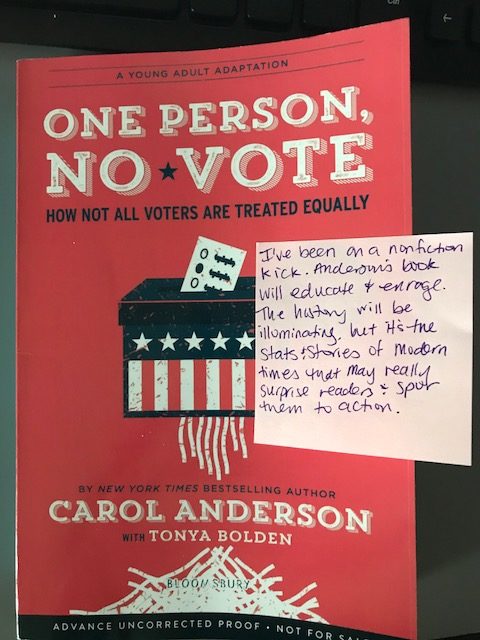
One Person, No Vote (YA edition): How Not All Voters Are Treated Equally by Carol Anderson, Tonya Bolden (ISBN-13: 9781547601073 Publisher: Bloomsbury USA Publication date: 09/17/2019)
From the award-winning, New York Times bestselling author of White Rage, a young readers’ edition of a startling—and timely—history of voter suppression in America.
In her New York Times bestseller White Rage, Carol Anderson laid bare an insidious history of policies that have systematically impeded black progress in America, from 1865 to our combustible present. With One Person, No Vote, she chronicles a related history: the rollbacks to African American participation in the vote since the 2013 Supreme Court decision that eviscerated the Voting Rights Act of 1965. Known as the Shelby ruling, this decision effectively allowed districts with a demonstrated history of racial discrimination to change voting requirements without approval from the Department of Justice.
Focusing on the aftermath of Shelby, Anderson follows the astonishing story of government-dictated racial discrimination unfolding before our very eyes as more and more states adopt voter suppression laws. In gripping, enlightening detail she explains how voter suppression works, from photo ID requirements to gerrymandering to poll closures. And with vivid characters, she explores the resistance: the organizing, activism, and court battles to restore the basic right to vote to all Americans as the nation gears up for the 2020 presidential election season.
(POST-IT SAYS: I’ve been on a nonfiction kick. Anderson’s book will educate and enrage. The history will be illuminating, but it’s the stats and stories of modern times that may really surprise readers and spur them to action.)
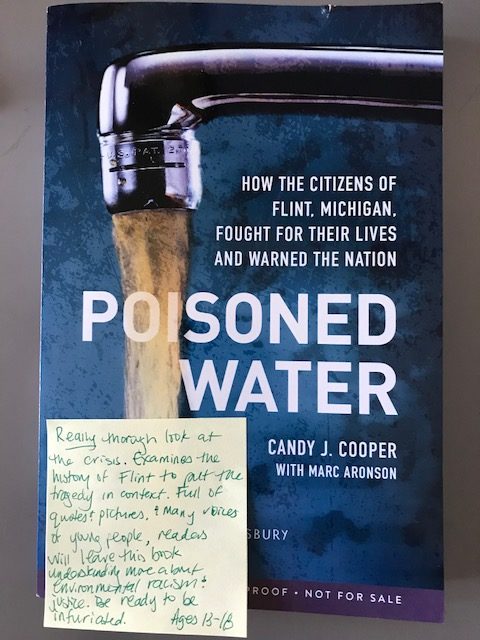
Poisoned Water: How the Citizens of Flint, Michigan, Fought for Their Lives and Warned the Nation by Candy J. Cooper, Marc Aronson
Based on original reporting by a Pulitzer Prize finalist and an industry veteran, the first book for young adults about the Flint water crisis
In 2014, Flint, Michigan, was a cash-strapped city that had been built up, then abandoned by General Motors. As part of a plan to save money, government officials decided that Flint would temporarily switch its water supply from Lake Huron to the Flint River. Within months, many residents broke out in rashes. Then it got worse: children stopped growing. Some people were hospitalized with mysterious illnesses; others died. Citizens of Flint protested that the water was dangerous. Despite what seemed so apparent from the murky, foul-smelling liquid pouring from the city’s faucets, officials refused to listen. They treated the people of Flint as the problem, not the water, which was actually poisoning thousands.
Through interviews with residents and intensive research into legal records and news accounts, journalist Candy J. Cooper, assisted by writer-editor Marc Aronson, reveals the true story of Flint. Poisoned Water shows not just how the crisis unfolded in 2014, but also the history of racism and segregation that led up to it, the beliefs and attitudes that fueled it, and how the people of Flint fought-and are still fighting-for clean water and healthy lives.
(POST-IT SAYS: Really thorough look at the crisis. Examines the history of Flint to put the tragedy in context. Full of quotes and pictures, and many voices of young people, readers will leave this book understanding more about environmental racism and justice. Be ready to be infuriated. Ages 13-18)
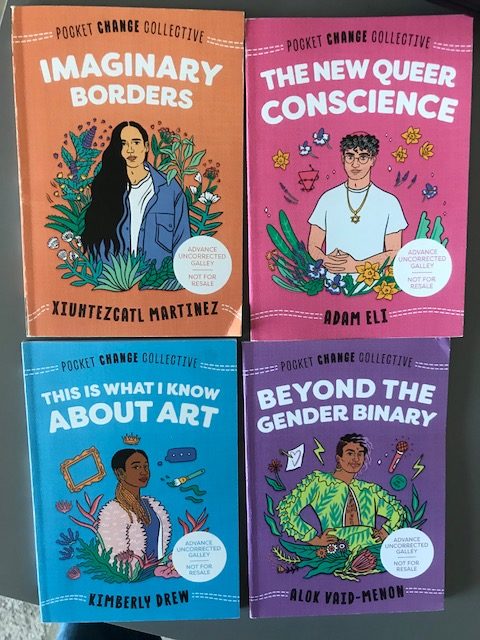
I’ve said it before, but: Almost always, I read books in order of publication date. It’s really the only way I can keep track of everything I want to review and juggle the rest of life. These little books have sat on my shelf for months and I’ve been so looking forward to getting to them. They did not disappoint.
You know who these would be great for? All the great kids you know who are graduating right now. I love giving books as gifts (she preached to the choir) and these are perfect to hand to young readers. And old readers! These books read like really impassioned TED talks, interspersing personal histories and details with factual information and calls to action.
In Beyond the Gender Binary, Vaid-Menon explores the many ways the false idea of a binary hurts everyone and how harmful the disconnect between what people see (and comment on) and who you are can be. They discuss how an emphasis on a binary involves power, control, shame, repression, harassment, discrimination, and more. They look at the laws against people who don’t conform to the gender binary, the access denied, the targeted legislation, and point out how so much of this is all about gender non-conforming people but rarely actually engages with them.
Vaid-Menon shares their own story from growing up, full of shame, fear, and bullying. They also detail common arguments against gender non-conforming people and refutes them. They emphasize the importance for the narrative around nonbinary people to be one of reclamation, acceptance, peace, and celebration in this powerful look at the toxic notion of a binary and the harmony and creativity of embracing a spectrum of gender identities.
In The New Queer Conscience, Eli focuses on providing a hopeful, uplifting message of support and solidarity as he calls for a unified queer community. Drawing parallels to the support and collective sympathy, outrage, and action he finds within his Jewish community, he urges queer people anywhere to feel responsible for queer people everywhere. He writes about being young and feeling confused and uncomfortable and desperately needing the validation, assurance, and support of a community. He addresses the common feeling of being alone that so many queer kids may feel, a feeling that could be alleviated by a stronger and more active community. Eli explores the changes necessary for this kind of community and transformation, including policies of kindness and understanding, acknowledging uneven playing fields and issues of privilege, and the need for there to be solidarity with all oppressed people. A great reminder that there’s a huge, welcoming community that values you and that together it can be stronger and more effective.
In Imaginary Borders, Martinez examines the climate change movement. His message is that we build the world together, especially when we understand that we are part of a larger system, that we need to claim space in the movements, and explores the need for a cultural shift. He details the ways climate change reaches across real and imagined borders and looks as the cascading effects of climate change, environmental racism, and social justice. Martinez focuses on the fact that there are many paths to activism, and that to inspire connection and action, we need to bring our imagination and creativity to the movement as well as diverse tactics.
In This Is What I Know About Art, Drew looks at art, activism, protest, and inclusion through the lens of her own path to a life in the art world. Emphasizing curiosity, engagement, and learning, she pushes for a collective voice and a shared community. Detailing her exploration of art in college and in internships and jobs, she encourages us to ask who is not in the room and how can we get them there.
Illuminating and inspiring, all four books encourage more thoughtful conversations around these topics. Really well done.
Review copies (ARC) courtesy of the publisher.
Last year at Teen Lit Con, I presented on Social Justice and Activism. You can see a post about this presentation here—reading lists are included and downloadable.
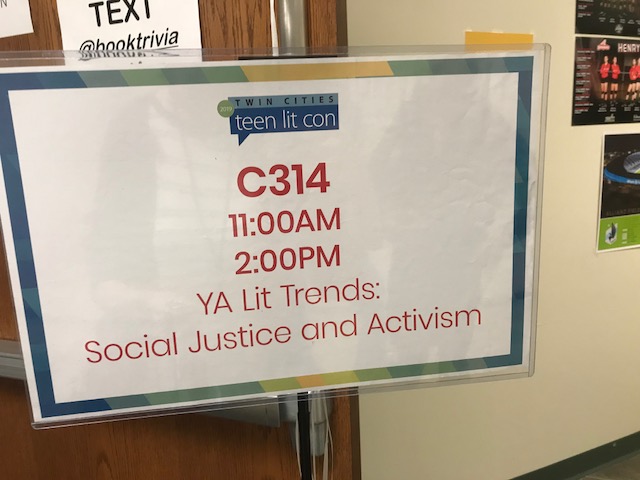
And finally….
I wanted to give some extra attention to two books I’ve loved in the past few years, both of which focus on teens in the Minneapolis area.
Dream Country by Shannon Gibney

Publisher’s description
The heartbreaking story of five generations of young people from a single African-and-American family pursuing an elusive dream of freedom.
Dream Country begins in suburban Minneapolis at the moment when seventeen-year-old Kollie Flomo begins to crack under the strain of his life as a Liberian refugee. He’s exhausted by being at once too black and not black enough for his African American peers and worn down by the expectations of his own Liberian family and community. When his frustration finally spills into violence and his parents send him back to Monrovia to reform school, the story shifts. Like Kollie, readers travel back to Liberia, but also back in time, to the early twentieth century and the point of view of Togar Somah, an eighteen-year-old indigenous Liberian on the run from government militias that would force him to work the plantations of the Congo people, descendants of the African American slaves who colonized Liberia almost a century earlier. When Togar’s section draws to a shocking close, the novel jumps again, back to America in 1827, to the children of Yasmine Wright, who leave a Virginia plantation with their mother for Liberia, where they’re promised freedom and a chance at self-determination by the American Colonization Society. The Wrights begin their section by fleeing the whip and by its close, they are then the ones who wield it. With each new section, the novel uncovers fresh hope and resonating heartbreak, all based on historical fact.
In Dream Country, Shannon Gibney spins a riveting tale of the nightmarish spiral of death and exile connecting America and Africa, and of how one determined young dreamer tries to break free and gain control of her destiny.
Amanda’s thoughts
Confession: I have been staring at the blank screen now for 18 minutes. I’ve been writing book reviews for 16 years, since I was in graduate school at Simmons. How many reviews have I written in those years—many hundreds, maybe more than a thousand? And yet here I sit, trying to put together even just one useful, coherent sentence that might begin to sum up how powerful, unique, and phenomenal this book is. I’m frowning as I type, because those words don’t even begin to do this novel justice.
The first thing you should know is that this novel will challenge readers, and I mean that in the best possible way. We move around in time and in place, and though there are parts of a family tree shown, I had to draw my own to start to make the connections clearer. You know who is up for challenging reads? Teenagers. They’ll be fine.
We’re first introduced to Kollie, a 16-year-old Liberian boy living in Brooklyn Center, Minnesota (just outside of Minneapolis) in 2008. His family fled Liberia during the Second Civil War and lived for three years in a refugee camp in Ghana. Many of his friends and classmates are Liberian, and there’s a lot of tension between the African immigrant kids and the black American kids. Kollie and his friends are regularly called slurs, called “jungle animals.” Things are not easy for Kollie, but he’s getting by. His parents have high hopes for him, that he can help be a positive influence in the community. His mother warns him that America may be the land of opportunity, “but if you want to destroy yourself, they will give you that opportunity too.” She says the world will do its best to convince black boys that they should destroy themselves, but she’s proud he’s working to better himself. Of course, this speech is before Kollie is involved in a violent incident at school, suspended, and working for William, a neighborhood “degenerate.” Devastated and ashamed, his parents send him away.
From here, we weave back and forth in time and location, meeting some of Kollie’s ancestors and following their struggles, losses, and achievements as they try to make their way through a world that doesn’t seem to want them to succeed or even to exist. Readers meet Togar, in 1926, in Grand Bassa County, Liberia, fleeing from Congo soldiers. We follow the story of Yasmine, who we meet in 1827 on a plantation near Norfolk, Virginia. The American Colonization Society’s new idea is to send “the coloreds” back to Africa’s Gold Coast to share their knowledge, experience, and salvation with the people there. Though this opportunity seems rife with potential, another woman there warns Yasmine that their new town is a hell and to stay away from hope. Yasmine and her family quickly realize that their new life is one filled with tension and fighting, and that the white men who came up with this idea weren’t looking to better anyone, but rather to ship people away to eliminate them. We also spend time with Evelyn and Ujay, in 1980, in Monrovia, Liberia, where we see Ujay’s work as an activist with the Progressive Alliance of Liberia and the hope for indigenous, not Congo, rule. We flash forward to 1994 with Ujay, now in a refugee camp near Ghana. And finally, we hear from Angel, Kollie’s sister, in 2018, ten years after Kollie was sent away from their family.
The stories are loosely tied together (in the sense that we’re following the line of one family and returning to the same place over and over), but read like short stories, complete on their own. It feels especially profound, then, when we reach Angel’s portion of the narrative and understand that it is she who has been telling all of these stories as a way to help make sense of her lineage, history, and ancestors. Through her revelations about her writing, readers see the choices she made in telling these stories, her search for explaining people and their actions, her desire for wholeness, for neat intertwining, for being able to know what these experiences were like. The title, Dream Country, takes on new significance through Angel’s eyes, and with Angel’s own story. This powerful and well-written story examines deep human emotions, the desire and fight for freedom, power, and immigrant experiences. Perhaps shamefully, I managed to make it to 40 without knowing much of anything at all about Liberia, but this book has changed that. Gibney’s complex look at one family, told through a wide scope, is moving and unlike anything I have ever read before in YA. This is one of the best books I’ve read this year. Don’t miss it.
Review copy (ARC) courtesy of the publisher
ISBN-13: 9780735231672
Publisher: Penguin Young Readers Group
Publication date: 09/11/2018
The Stars and the Blackness Between Them by Junauda Petrus
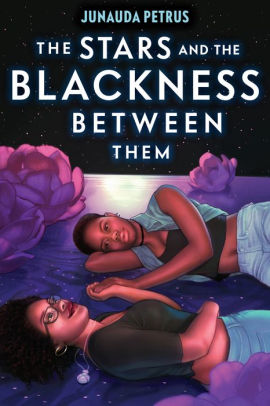
Publisher’s description
Told in two distinct and irresistible voices, Junauda Petrus’s bold and lyrical debut is the story of two black girls from very different backgrounds finding love and happiness in a world that seems determined to deny them both.
Trinidad. Sixteen-year-old Audre is despondent, having just found out she’s going to be sent to live in America with her father because her strictly religious mother caught her with her secret girlfriend, the pastor’s daughter. Audre’s grandmother Queenie (a former dancer who drives a white convertible Cadillac and who has a few secrets of her own) tries to reassure her granddaughter that she won’t lose her roots, not even in some place called Minneapolis. “America have dey spirits too, believe me,” she tells Audre.
Minneapolis. Sixteen-year-old Mabel is lying on her bed, staring at the ceiling and trying to figure out why she feels the way she feels—about her ex Terrell, about her girl Jada and that moment they had in the woods, and about the vague feeling of illness that’s plagued her all summer. Mabel’s reverie is cut short when her father announces that his best friend and his just-arrived-from-Trinidad daughter are coming for dinner.
Mabel quickly falls hard for Audre and is determined to take care of her as she tries to navigate an American high school. But their romance takes a turn when test results reveal exactly why Mabel has been feeling low-key sick all summer and suddenly it’s Audre who is caring for Mabel as she faces a deeply uncertain future.
Junauda Petrus’s debut brilliantly captures the distinctly lush and lyrical voices of Mabel and Audre as they conjure a love that is stronger than hatred, prison, and death and as vast as the blackness between the stars.
Amanda’s thoughts
That summary up there is thorough. I just read it again, when I pasted it in, to see if it’s too thorough—after all, it really hits every major plot point. But while it gives you the broad strokes of the plot, it doesn’t do much to capture how powerful the story is, how beautiful the writing is, or how achingly lovely and profound the connection is between Agnes and Mabel. To be entirely honest, the book started a little slow for me, but once Agnes and Mabel are put in the same space, the story really took off and I became completely immersed in their world, their families, their big thoughts and feelings, and their love.
There is so much to love about this story. Yes, Agnes is sent away when her mother catches her with her girlfriend. She’s shamed and told she’s “nasty” by her mother. But she finds love, support, and acceptance from everyone else in her life. Mabel finds kissing her boyfriend kind of boring, but even just being near her friend Jada makes her all tingly. She’s working out what all this means, but it’s not angst-filled or painful or met with any hate. In Minneapolis, they are surrounded by supportive family and friends, many of whom are queer. And for Agnes, she has Queenie, her grandma, back home in Trinidad, who has always been her closest and most loving person. Queenie fully accepts Agnes for who she is—she always has—and fills with her love, always reminding her of her self-worth and that she’s perfect as she is.
While the story alternates between Mabel and Agnes, we also get some unexpected perspectives. There are chapters about Queenie’s younger life as well as chapters from a memoir Mabel is reading. Written by Afua Mahmoud while incarcerated, The Stars and the Blackness Between Them (his memoir) provides surprising points of connection for Mabel, who feels less alone as she reads his thoughts on life while dealing with her new diagnosis of a terminal illness. All of these voices and experiences speak of hope, connection, loneliness, love, isolation, and freedom. After they become pen pals, Afua tells Mabel that, despite his circumstances, his life is still his own, and so is hers.
Through the lenses of freedom and love, the characters ruminate on the past, the present, and an eternal future found through cosmic connections. They learn to be uncontained, to love without fear or boundaries, to give themselves the space to figure out who they are. The voices from this stunning debut will stay with readers long after the unpredictable ending. Full of love, healing, strength, and spirituality, this is a story that hasn’t been told before—not like this. Be ready to lose a day once you start reading; Mabel and Agnes will draw you into their worlds and not release their grip on you even after the last page. A lovely story that is sad and hopeful all at once.
Review copy courtesy of the publisher
ISBN-13: 9780525555483
Publisher: Penguin Young Readers Group
Publication date: 09/17/2019
Filed under: Uncategorized
About Amanda MacGregor
Amanda MacGregor works in an elementary library, loves dogs, and can be found on Twitter @CiteSomething.
ADVERTISEMENT
ADVERTISEMENT
SLJ Blog Network
The 2024 Ninja Report: Bleak
A Sequel Coming This Summer That You Won’t Want to Miss: Bob Shea Discusses His Latest
Review| Agents of S.U.I.T. 2
ADVERTISEMENT







